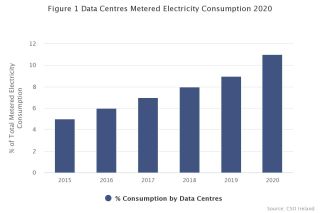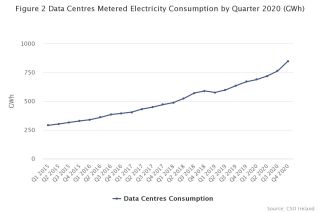Time for policy coherence to meet climate goals

Electricity consumption by data centres has increased by 144% between 2015 and 2020. This is according to the most recent data from the CSO on the metred electricity consumption of data centres. There is a mismatch between pursuing a policy of data centre expansion, and the pressure that this will put on energy resources whilst simultaneously trying to reduce our energy emissions. This is an example of the policy incoherence that must be addressed if Ireland is to meet the targets set out in the Climate Action Plan. All of Government policies should be supporting our climate and environmental goals rather than inhibiting progress towards those goals.
|
Table 1 Metered Electricity Consumption 2020 |
||||
|
|
Gigawatt hours |
% of Total |
||
|
Year |
Data Centre |
Other Metered Customers |
Total |
% Data Centre |
|
2015 |
1,236 |
23,364 |
24,600 |
5 |
|
2016 |
1,477 |
23,879 |
25,356 |
6 |
|
2017 |
1,755 |
23,970 |
25,725 |
7 |
|
2018 |
2,172 |
24,558 |
26,730 |
8 |
|
2019 |
2,478 |
24,027 |
26,505 |
9 |
|
2020 |
3,019 |
24,037 |
27,056 |
|
Source: CSO Ireland 2022
In addition, the percentage of metred electricity consumed by data centres rose from 5% in 2015 to 11% in 2020. This was an increase of 1,783 Gigawatt hours between 2015 and 2020.

There has been a steady increase in consumption on a quarterly basis between 2015-2020, from 290 Gigawatt hours in the first quarter of 2015 to 849 Gigawatt hours in the fourth quarter of 2020. This was driven by (i) existing data centres using more electricity and (ii) new data centres being added to the national grid.

Social Justice Ireland view
The additional subsidisation costs for data centres (including data centres consumption of renewable energy) are in part borne by residential and other commercial customers. The challenges of pursuing a policy of data centre expansion whilst setting ambitious climate goals was explored in detail by Dr Patrick Bresnihan in our podcast series last year. As a very first step towards addressing this type of policy coherence Social Justice Ireland proposed that Government in Budget 2022 reorganise the PSO levy according to average demand. This would ensure that each sector is responsible for the proportion of renewable electricity that it gives rise to. This would have be a first step to ensure that Data Centres make an appropriate contribution to Ireland’s renewable energy targets.
There is a mismatch between pursuing a policy of data centre expansion, and the pressure that this will put on energy resources whilst simultaneously trying to reduce our energy emissions. Eirgrid found in their ‘All-Island Generation Capacity Statement 2019-2028’ that forecasted energy demand in Ireland continues to be heavily influenced by the expected growth of large energy users, primarily data centres. Data centres can require the same amount of energy as a small town and Eirgrid forecast that 29 per cent of total energy demand will come from data centres by 2028. More recently, in January 2022 Eirgrid confirmed a moratorium on data centre expansion in Dublin due to pressures on the national grid and in particular in the greater Dublin area This is an example of the policy incoherence that must be addressed if Ireland is to meet the targets set out in the Climate Action Plan. All of Government policies should be supporting our climate and environmental goals rather than inhibiting progress towards those goals.
